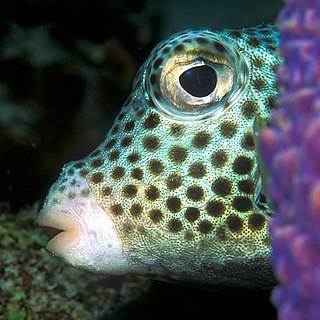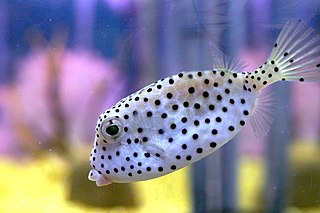
Ostraciidae or Ostraciontidae is a family of squared, bony fish belonging to the order Tetraodontiformes, closely related to the pufferfishes and filefishes. Fish in the family are known variously as boxfishes, cofferfishes, cowfishes and trunkfishes. It contains about 23 extant species in 6 extant genera.

Ostracion is a genus of is a genus of marine ray-finned fishes belonging to the family Ostraciidae, the boxfishes. These fishes are found in the Indo-Pacific region as far east as the eastern Pacific coasts of the Americas.

Aracana is a genus of marine ray-finned fishes belonging to the family Aracanidae, the deepwater boxfishes or temperate boxfishes. These fishes are endemic to the waters around Australia.

Caprichthys is a monospecific genus of marine ray-finned fish belonging to the family Aracanidae, the deepwater boxfishes or temperate boxfishes. The only species in the genus is the rigid boxfish, also known as the black-spotted boxfish or ornate pigmy boxfish which is endemic to southwestern Australia.

Kentrocapros is a genus of marine ray-finned fishes belonging to the family Aracanidae, the deepwater boxfishes or temperate boxfishes. These fishes are found in the coastal waters of the Indian and Pacific Oceans.
Polyplacapros is a monospecific genus of ray-finned fish beloning to the family Aracanidae, the temperate boxfishes or deep water boxfishes. The only species in the genus is Polyplacapros tyleri, Tyler's boxfish, which is found in the southwestern Pacific Ocean.

Lactophrys is a genus of marine ray-finned fishes belonging to the family Ostraciidae, the boxfishes. The boxfishes in this genus are found in the western Atlantic Ocean and are known as trunkfishes.

Lactoria is a genus of marine ray-finned fishes belonging to the family Ostraciidae, the boxfishes. The fishes in this genus are found in the Indo-Pacific, with one species extending into the southeastern Atlantic.

Tetrosomus is a genus of marine ray-finned fishes belonging to the family Ostraciidae, the boxfishes. The fishes in this genus are known as turretfishes and they are found in the Indian and western Pacific Oceans.

Ostracion rhinorhynchos, the horn-nosed boxfish or torpedo boxfish, is a species of ray-finned fish belonging to the family Ostraciidae, the boxfishes. This fish occurs in the Indo-West Pacific region.

Aracana aurita, Shaw's cowfish, painted boxfish, Southern cowfish or striped cowfish, is a species of marine ray-finned fish belonging to the family Aracanidae, the deepwater boxfishes or temperate boxfishes. This species is endemic to the seas off southern Australia.

Lactophrys trigonus, the buffalo trunkfish or trunkfish, is a species of marine ray-finned fish belonging to the family Ostraciidae, the boxfishes. The buffalo trunkfish is found in the Western Atlantic Ocean.

The island cowfish, also known as the hogfish, bottlefish boxfish or island boxfish, is a species of marine ray-finned fish belonging to the family Ostraciidae, the cowfishes. This fish is found around the islands of the mid-Atlantic Ocean and has beeen recorded from Western Africa.

Lactoria diaphana, the roundbelly cowfish, diaphonous cowfish, many-spined cowfish, spiny cowfish or transparent cowfish, is a species of marine ray-finned fish belonging to the family Ostraciidae, the boxfishes. This fish is found in the southeastern Atlantic Ocean and the Indo-Pacific.

The Western smooth boxfish, also known as the blue boxfish or robust boxfish, is a species of marine ray-finned fish belonging to the family Aracanidae, the deep water boxfishes or temperate boxfishes. This fish is endemic to the seas of southwestern Australia.

Kentrocapros aculeatus, the Itomaki basketfish, is a species of marine ray-finned fish beloning to the family Aracanidae, the temperate boxfishes or deepwater boxfishes. This species is found in the north western and central Pacific Ocean.
Kentrocapros flavimaculatus is a species of marine ray-finned fish belonging to the family Aracanidae, the temperate boxfishes or deepwater boxfishes. This species is found in the southwestern Pacific Ocean around New Zealand and was first formally described in 2023.
Kentrocapros rosapinto, the basketfish, is a species of marine ray-finned fish belonging to the family Aracanidae, the temperate boxfishes or deepwater boxfishes. This fish is found in the Western Indian Ocean and in the southeastern Atlantic Ocean.
Kentrocapros spilonotus, the Hawaiian basketfish, is a species of marine ray-finned fish belonging to the family Aracanidae, the temperate boxfishes or deepwater boxfishes. This species is known from two places in the Hawaiian Islands, one near Laysan and the other is the Penguin Bank.

Whitley's boxfish is a species of marine ray-finned fish belonging to the family Ostraciidae, the boxfishes. This fish is found in the Eastern Central Pacific Ocean.













